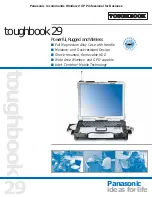
5 of 12
Step 1. Beginning with the lowest shelf containing string A & B, place each of the individual front
access batteries on the shelf (4 per shelf) with approximately 1/2 inch spacing between the individual
units. All the batteries should be placed with terminals to the front of the rack / shelf. Remove and
save terminal protectors (see Figures 5 & 6). Place a safety shield in the center of the tray
between adjacent 24 volt battery strings.
Step 2. C&D recommends, prior to connection of inter-unit bus bars and/or cables, the battery
terminals and all contact surfaces should be cleaned, lightly brushed with a brass bristle brush or
scotch brite type pad and lightly coated with protective No-Ox-Id terminal grease.
Step 3a. Starting at the battery on the far right of the tray, which is to be the positive (+) output, label
it as number 1 and then label the adjacent battery to the left as battery number two, string A. Repeat
the numbering procedure for the adjacent string (next two batteries to the left), string B. (see Figures 4,
5 & 6).
Step 3b. If more than two 24 VDC strings is within the enclosure, number these batteries the same way.
Identify the bottom tray as string A and B with the strings above as string C and D and so on (see Figure 5).
Step 4. Properly insulate the String A power supply negative (-) cable lug that will eventually be connected to
battery 2A’s negative (-) terminal.
Step 5. Connect String A’s power supply positive (+) cable onto battery number 2A’s positive (+) terminal
using the provided bolt and washer for 24 volt DC systems (cable coming from circuit breaker shown in Figure
4). Tighten bolt washer assembly hand tight.
Step 6. Using the provided bus bar and hardware (bolt and washer), connect between battery 1A’s negative (-)
terminal to battery 2A’s positive (+) terminal. Tighten bolt washer assembly hand tight.
Step 7. DO NOT connect the power supply positive cable to battery 2A’s negative (-) terminal.
Step 8. Torque all the bolt washer assemblies as per the inch-pound specifications in Table 1 (except the
remaining negative (-) power supply cable).
Step 9. Carefully remove the earlier applied insulation from the power supply negative (-) cable lug. Do not let
the power supply negative (-) cable touch any terminals or any conductive surface.
Step 10. Switch the string A circuit breaker to the on position, assuming a positive (+) leg circuit breaker as
noted in Figure 4 (if applicable).
Step 11. To make sure the battery is connected properly, place the voltmeter’s negative probe on battery 2A’s
negative (-) terminal and the voltmeter’s positive probe to the power supplies negative (-) lug. Check to make
sure the polarity is correct (not negative). If the value is negative (-), then the system was not wired properly
and must be corrected before it is hooked up to the power supply.
Step 12. If step 12’s value was positive (+), do not connect the negative (-) cable lug to battery 2A’s negative (-
) terminal, again wrap and insulate the enclosures negative (-) cable’s lug. Switch String A circuit breaker to
the off position (if applicable).
Step 13. If using a thermal probe, before inserting the washer and bolt onto battery 2A’s negative (-) terminal,
place the power supply’s thermal probe on top of the negative power supply lug (if applicable noted on Figure
4).
Step 14. Connect the power supply negative (-) cable lug to Battery 2A’s negative (-) terminal tightening the
bolt washer assembly hand tight. Torque to the specification in table 1.
Step 15. Switch string A’s circuit breaker to the on position (if applicable).
Step 16. Replace the previously removed terminal protectors.
Содержание TEL12-105FS
Страница 7: ...7 of 12...
Страница 8: ...8 of 12...
Страница 9: ...9 of 12...
Страница 10: ...10 of 12...
Страница 11: ...11 of 12...
Страница 12: ...12 of 12...






























